One man’s trash is another man’s treasure,
And one woman’s work is another one’s pleasure.
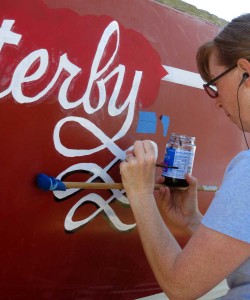
On a warm, sunny day like last Saturday, the boatyards are full of all kinds of painters. You can tell the bottom-painters by their green or blue hair. Topsides-painters don’t usually have colorful hair, just colorful language. Every gnat who drops an infinitesimal bit of dust on their perfect mirror finish provokes a new and interesting batch of swear-words.
Less common are the traditionalists who paint the name of their boat, using a marl-stick, instead of ordering vinyl stickers. I didn’t know what a marl-stick was before I painted “Flutterby” on the side of Flutterby.
The least common painters are the women I saw last Saturday, who had colorful smocks and sweaters instead of colorful hair and language. Before they began, they walked around the yard, holding up their fingers to make little rectangular frames. Then they set up their French box easels and went to work on pristine white canvases.
They were “plein-air” painters: People who go outdoors to paint pictures. They follow in the tradition of artists like Money, Pisarro, Van Gogh, and Renoir, taking advantage of natural light to create images on location.
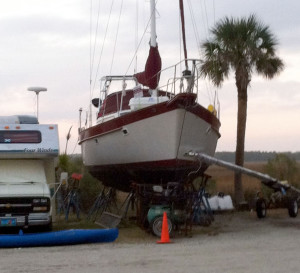
But here, in an industrial boatyard, full of heavy equipment?
I struck up a conversation with one of the painters, commenting, “Every day, I ride my bicycle five miles to the library to draw. Then you guys drive all the way out here to paint!” “Oh, you should join us,” she told me, earnestly.
I shook my head. I couldn’t take a day off just to paint a pretty picture.
I asked what brought them out to the boatyard, because she’d told me she came from Fernandina Beach, about 45 minutes away. “We love the shapes of the boats,” she said, looking over my shoulder at a row of hauled-out sailboats. I turned and took in the scene. I saw a compressor, an orange pylon, a blue plastic kayak, a small RV, and in the middle, an average-looking fiberglass boat with a lot of stuff on the deck.
Then I looked at her painting. She had simply painted the maroon and white sailboat, capturing the classic lines of the yacht and the marshes behind it. All the ugly stuff was absent.
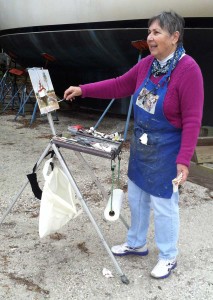
Suddenly, the whole boatyard looked different to me. “It’s about what you leave out, isn’t it?” I said, more to myself than to her.
In the days since then, I’ve looked at this place through new eyes. I’ve noticed the lines of the tugboat against a dazzling sunset. I’ve noticed the perfect reflection of a rusty crane in the water. I’ve noticed some breathtakingly colorful oil slicks.
For years, I’ve been telling Barry that living in boatyards is no fun, that these places don’t speak to my “artist’s soul.” But if artists are driving out here deliberately, in order to make art, I’d better rethink that perspective.
There’s a wonderful lesson for all of us from the plein-air painters. We see what we choose to see. No matter where we are, we can choose to see beauty and goodness with a little imagination.
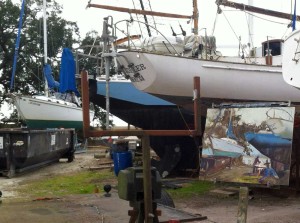
~

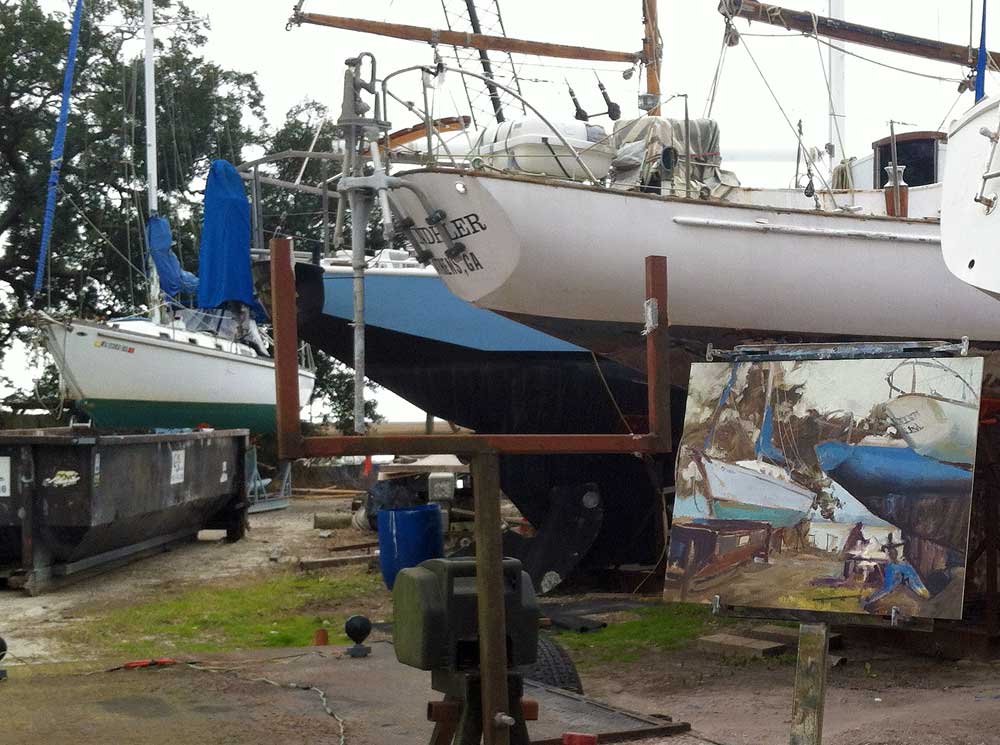
I think you’ve turned a corner. I’m not a visual artist, but I’ve learned to write essays reasonably well. Writing, for me, consists of showing the reader what’s real and relevant to the essay topic and, just as importantly, editing until nothing else remains. I see a parallel to plein-air painter showing her audience the lines and of the boat and the marsh, leaving out the other things that, while real, were not part of her vision.
Perspective is the rein and rudder of painting. ~Leonardo DaVinci
Interesting post Meps. I especially enjoyed the descriptions of bottom-painters and topside-painters, so true and funny!